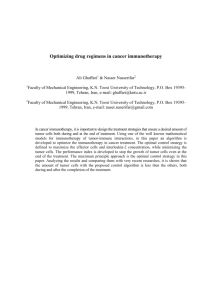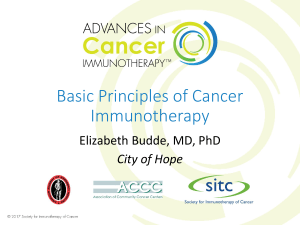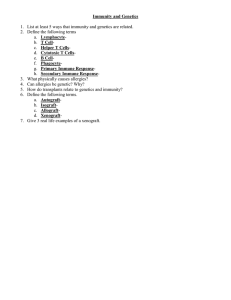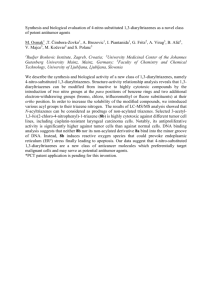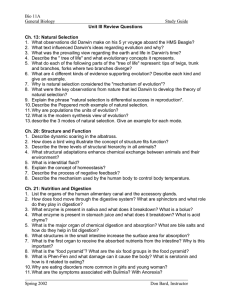Immunology in Head and Neck Cancer Stephanie Cordes, MD Christopher Rassekh, MD
advertisement
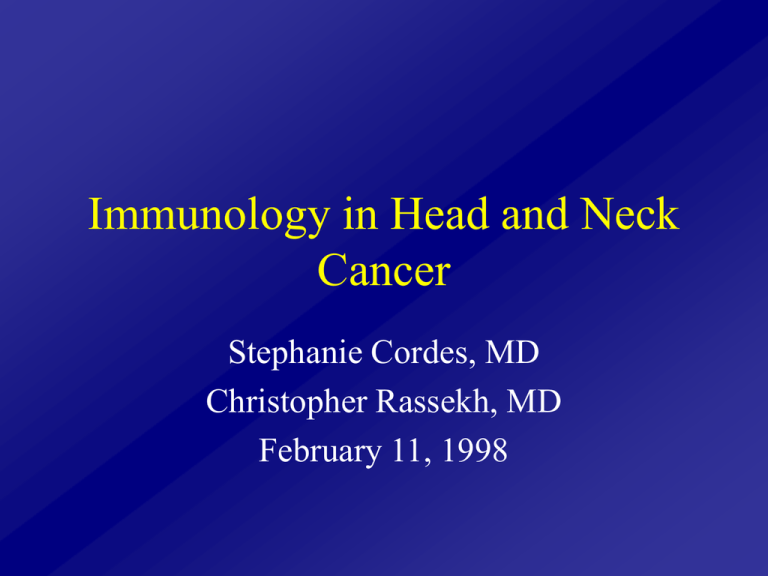
Immunology in Head and Neck Cancer Stephanie Cordes, MD Christopher Rassekh, MD February 11, 1998 Tumor Immunology • • • • • • recognize and react against tumors prevent initial appearance or limit growth recognition not as effective histology shows mononuclear infiltrate patients with impaired immunocompetence complex role Malignant Transformation • result of errors in genetic programming • chemical, physical, or viral carcinogens • multistep process – initiation : alterations in cellular DNA – promotion : altered presentation of genetic information – progression : abnormal phenotypes cloned Risk Factors for Head and Neck Cancer • • • • • • Tobacco : carcinogens initiate and promote Alcohol : additional promoter Viruses : Ebstein-Barr and HSV Nutritional status Ionizing radiation : injures cellular DNA Interference with immunity Immunosuppression • • • • • • etiology is multifactorial alcoholism: abnormalities in B and T cells malnutrition: impairs B and T cell response viruses: effect immunity aging: cellular immunity wanes tobacco: decrease cytotoxicity and reactivity Immune Recognition of Tumors • • • • • • immunosurveillance tumor-specific antigens tumor-associated antigens monoclonal antibody technology major histocompatibility complex still inadequate immune response to tumor Immunologic Escape • • • • • • • • tumor kinetics antigenic modulation antigen masking blocking factors tolerance genetic factors tumor products growth factors Immune Response to Tumor • Cellular immune system • Humoral immune system Cell-mediated Immunity • helper, suppressor, and cytotoxic lymphocytes • activation produces lymphokines • patients have altered immune function • peripheral total lymphocytes • Wanebo et al -decrease in total B and T cells and decreased stimulation Regional Immune Reactivity • draining lymph node morphology • Berlinger et al - evaluated 84 patients • active immunological response - greater five year survival • depleted or unstimulated response - no patients alive at five years • relationship between regional immunoreactivity and survival Humoral Immunity • augments cellular response • immunoglobulins – – – – – serum glycoproteins produced by B cells specificity in binding to substrate two heavy and two light chains heavy chain type determines class variable region is antigen binding site Response to Cancer • immunoglobulins : IgG and IgA primarily • IgG : functions by fixing complement and via ADCC • IgA : confers protective effect to tumor • immune complexes : elevated in patients • cytokines : interleukin, interferon, growth factor, and colony-stimulating factor Interferon • three subclasses – type I : interferon alpha and beta – type II : interferon gamma • mediate a large range of biologic responses • interferon gamma – direct cytotoxic effects – combined with chemotherapy – enhances antitumor effects of other cytokines Interleukins • Interleukin 1 – immunologic, inflammatory, and reparative – induces production of interleukin 2 • Interleukin 2 – produced by activated T lymphocytes – stimulates T, B, and NK cell proliferation • Interleukin 4 • Tumor growth factor beta Potential for Therapy • Active immunotherapy – administer agents that activate immune reaction – goal is to stimulate areas responsible for antitumor immunity • Passive immunotherapy – administer externally stimulated immunologic components – initially obtained from patient Active Immunotherapy • Tumor Vaccines : development limited • Biological Response Modifiers – BCG – interferon – interleukin 2 Passive Immunotherapy • Monoclonal Antibodies • Cytotoxic Reagents – – – – radioisotopes toxins chemotherapeutic drugs cytokines Conclusion • immunosuppression more frequent • patients have leukocytes with antitumor reactivity • attempts at immunotherapy are not effective • study may lead to improvement in diagnosis and to determining prognosis
